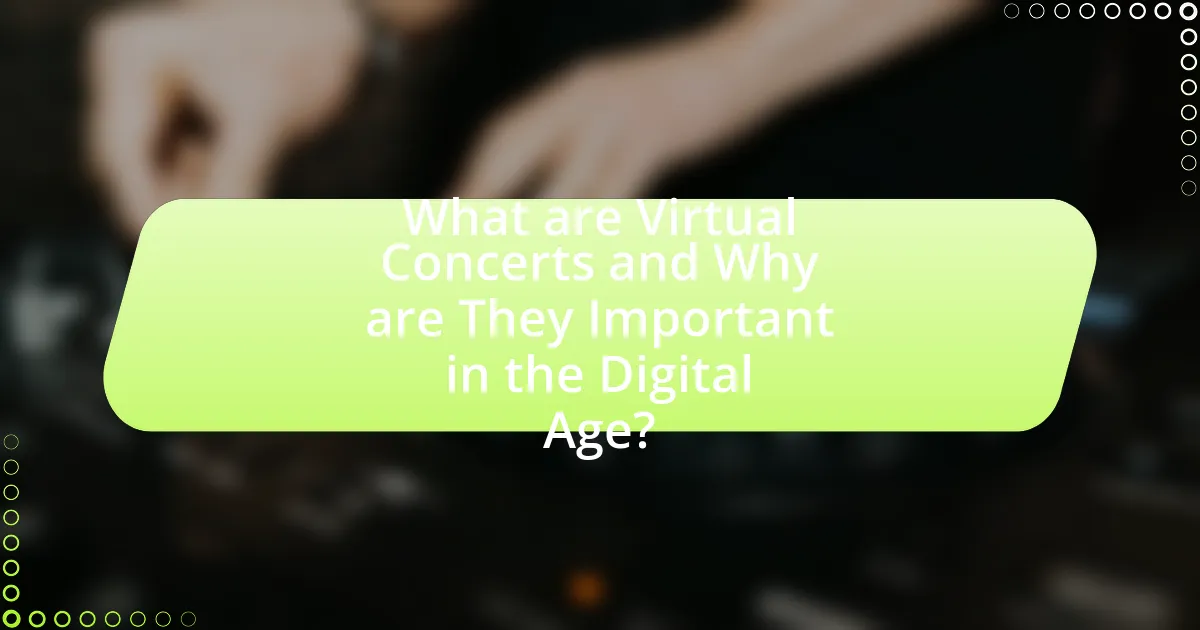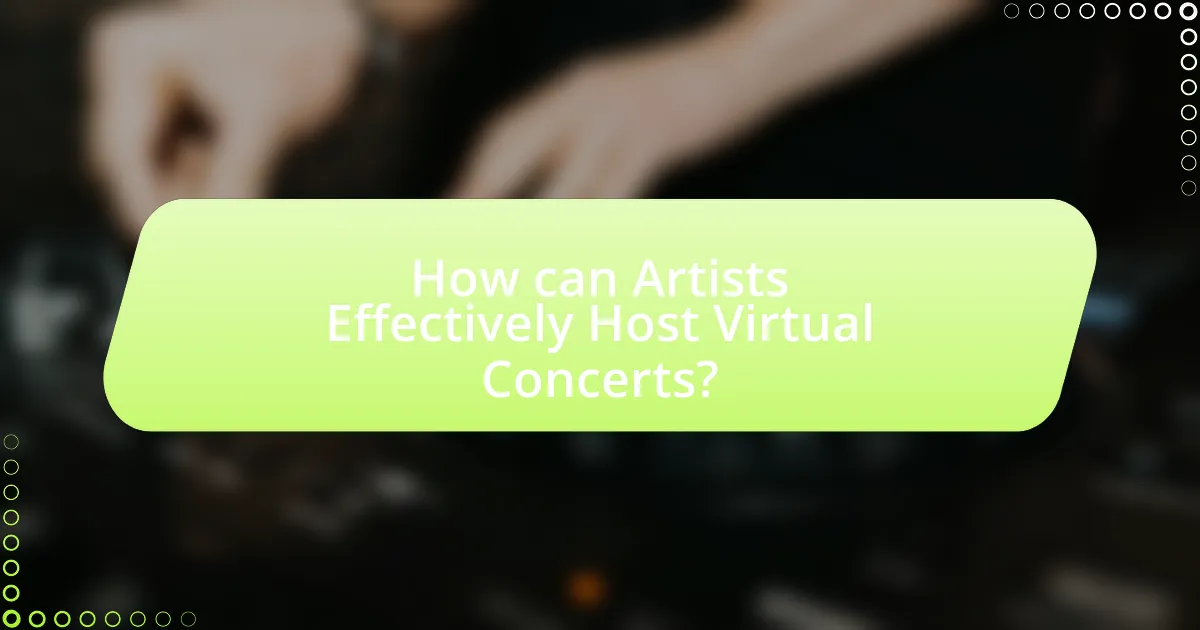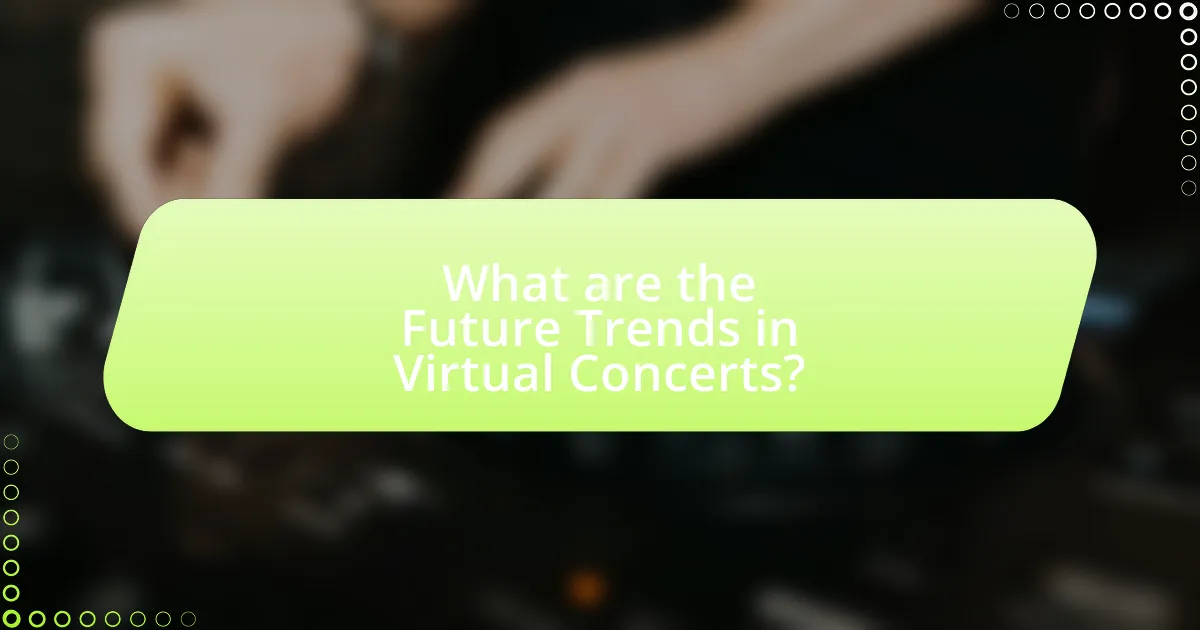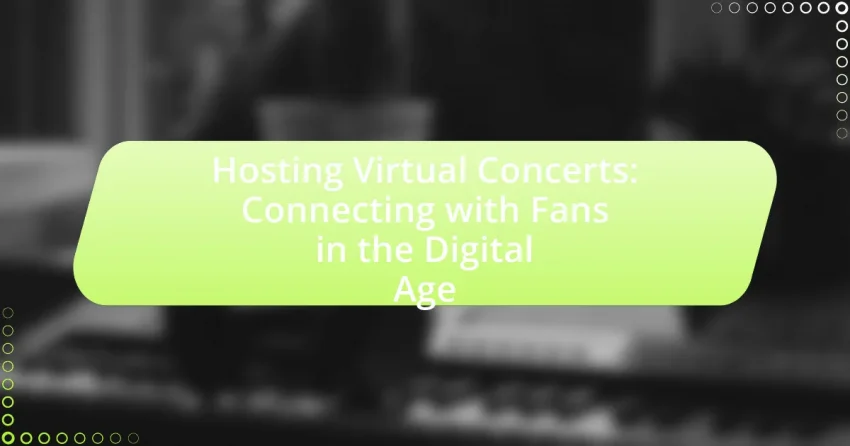Virtual concerts are live performances streamed online, enabling artists to connect with global audiences without geographical constraints. This article explores the significance of virtual concerts in the digital age, highlighting their growth, technological advancements, and the differences from traditional concerts. Key features for successful virtual events, including high-quality production and audience engagement strategies, are discussed, along with the challenges artists face, such as technical issues and monetization. Additionally, the article examines the role of social media in promoting virtual concerts and the future trends that may shape the music industry, including the integration of augmented and virtual reality technologies.

What are Virtual Concerts and Why are They Important in the Digital Age?
Virtual concerts are live performances streamed online, allowing artists to reach global audiences without geographical limitations. They are important in the digital age because they provide a platform for artists to connect with fans, especially during times when physical gatherings are restricted, such as during the COVID-19 pandemic. According to a report by Statista, the global virtual concert market was valued at approximately $1.1 billion in 2021 and is projected to grow significantly, highlighting the increasing demand for digital experiences in the music industry. This shift not only enhances accessibility for fans but also opens new revenue streams for artists through ticket sales, merchandise, and sponsorships.
How do Virtual Concerts differ from Traditional Concerts?
Virtual concerts differ from traditional concerts primarily in their format and accessibility. Virtual concerts are conducted online, allowing audiences to participate from anywhere with an internet connection, while traditional concerts occur in physical venues, requiring attendees to be present at a specific location. This difference in format enables virtual concerts to reach a global audience, as evidenced by events like the 2020 “One World: Together at Home” concert, which attracted over 270 million viewers worldwide. Additionally, virtual concerts often incorporate interactive elements such as live chats and social media integration, enhancing audience engagement in ways that traditional concerts cannot.
What technologies enable Virtual Concerts?
Virtual concerts are enabled by several key technologies, including streaming platforms, virtual reality (VR), augmented reality (AR), and interactive software. Streaming platforms like YouTube, Twitch, and specialized services allow artists to broadcast live performances to global audiences. Virtual reality creates immersive environments where fans can experience concerts as if they were physically present, while augmented reality enhances the live experience with digital overlays. Interactive software facilitates audience engagement through features like chat, polls, and virtual meet-and-greets, enhancing the overall concert experience. These technologies collectively transform how artists connect with fans in the digital age.
What are the key features of a successful Virtual Concert?
Key features of a successful virtual concert include high-quality audio and video production, interactive audience engagement, and a well-planned marketing strategy. High-quality audio and video ensure that the performance is enjoyable and immersive, as evidenced by platforms like Twitch and YouTube, which prioritize streaming quality. Interactive audience engagement can involve live chats, polls, and virtual meet-and-greets, enhancing the connection between artists and fans, as seen in events like the Travis Scott Fortnite concert, which attracted millions of participants. A well-planned marketing strategy is crucial for reaching a wider audience and includes social media promotion and collaborations, which have proven effective in driving attendance for virtual events.
Why have Virtual Concerts gained popularity among artists and fans?
Virtual concerts have gained popularity among artists and fans due to their accessibility and ability to reach a global audience. Artists can perform from anywhere, eliminating geographical barriers and allowing fans from different regions to participate without travel costs. For instance, during the COVID-19 pandemic, platforms like Twitch and YouTube saw a significant increase in virtual concert viewership, with some events attracting millions of viewers simultaneously. This shift not only provides artists with new revenue streams through ticket sales and merchandise but also enhances fan engagement through interactive features like live chats and virtual meet-and-greets.
What role does social media play in promoting Virtual Concerts?
Social media plays a crucial role in promoting virtual concerts by providing a platform for artists to reach a wide audience quickly and effectively. Through targeted advertising, artists can engage with fans, share event details, and create buzz around their performances. For instance, platforms like Facebook and Instagram allow artists to utilize features such as live streaming, stories, and event pages to enhance visibility and interaction. According to a 2021 report by Eventbrite, 70% of event organizers found social media to be the most effective channel for promoting virtual events, highlighting its significance in driving attendance and engagement.
How do Virtual Concerts enhance fan engagement?
Virtual concerts enhance fan engagement by providing interactive experiences that allow fans to connect with artists in real-time. These events often include features such as live chats, virtual meet-and-greets, and social media integration, which foster a sense of community among attendees. For instance, a study by Eventbrite found that 70% of fans felt more connected to artists after participating in virtual events, highlighting the effectiveness of these platforms in building relationships. Additionally, virtual concerts can reach a global audience, allowing fans from different geographical locations to participate, thus expanding the artist’s reach and engagement potential.
What challenges do artists face when hosting Virtual Concerts?
Artists face several challenges when hosting virtual concerts, including technical issues, audience engagement, and monetization. Technical issues such as poor internet connectivity or inadequate streaming equipment can disrupt the performance and diminish the viewer experience. Audience engagement is another significant challenge, as artists must find innovative ways to connect with fans in a virtual setting, often lacking the immediate feedback and energy present in live performances. Monetization also poses difficulties, as artists may struggle to generate revenue through ticket sales or sponsorships compared to traditional concerts. According to a report by the International Federation of the Phonographic Industry, 75% of artists reported lower earnings from virtual events compared to live shows, highlighting the financial challenges they face in this format.
How can technical issues impact the experience of a Virtual Concert?
Technical issues can significantly detract from the experience of a virtual concert by causing disruptions such as audio and video lag, which can lead to a disconnection between the performer and the audience. For instance, a study by the International Journal of Human-Computer Interaction found that 70% of users reported decreased enjoyment due to buffering and poor sound quality during live-streamed events. These technical problems can result in frustration, reduced engagement, and a negative perception of the event, ultimately impacting the overall success of the concert.
What are the financial implications of hosting Virtual Concerts?
Hosting virtual concerts can lead to significant financial implications, including reduced overhead costs and potential revenue generation through ticket sales and merchandise. Unlike traditional concerts, virtual events eliminate expenses such as venue rental, physical security, and travel costs for artists, which can save organizers substantial amounts. For instance, a report by Eventbrite indicated that virtual events can have lower production costs, allowing for higher profit margins. Additionally, virtual concerts can reach a global audience, increasing ticket sales beyond local markets; in 2020, the virtual concert by Travis Scott in Fortnite attracted over 12 million viewers, showcasing the potential for massive revenue streams. Furthermore, partnerships with brands and sponsorships can enhance financial returns, as companies seek to engage with audiences in innovative ways. Overall, the financial implications of hosting virtual concerts can be favorable, provided that organizers effectively leverage digital platforms and marketing strategies.

How can Artists Effectively Host Virtual Concerts?
Artists can effectively host virtual concerts by utilizing high-quality streaming platforms, engaging with their audience through interactive features, and promoting the event across multiple channels. High-quality streaming platforms, such as YouTube Live or Twitch, ensure a seamless viewing experience, which is crucial for audience retention. Engaging with the audience can be achieved through live chats, Q&A sessions, and social media interactions during the concert, fostering a sense of community. Promotion through social media, email newsletters, and collaborations with influencers can significantly increase visibility and attendance. According to a report by Eventbrite, 80% of event organizers found that social media was the most effective way to promote virtual events, highlighting the importance of a robust marketing strategy.
What steps should artists take to plan a Virtual Concert?
Artists should take the following steps to plan a Virtual Concert: define the concert’s purpose and target audience, select an appropriate platform for streaming, create a detailed schedule including rehearsal times, promote the event through social media and email marketing, and ensure high-quality audio and video production.
Defining the concert’s purpose helps in tailoring the content to engage the audience effectively. Choosing a streaming platform, such as YouTube Live or Twitch, is crucial for accessibility and audience reach. A detailed schedule ensures that all technical aspects are covered, and promotion increases visibility, which is essential for attendance. High-quality production is vital, as studies show that better audio and video quality significantly enhance viewer experience and retention.
How do you choose the right platform for hosting a Virtual Concert?
To choose the right platform for hosting a virtual concert, evaluate the platform’s features, audience reach, and technical capabilities. Key features to consider include streaming quality, interactivity options, ticketing systems, and user experience. Platforms like YouTube Live and Twitch offer broad audience access, while specialized services like Stageit provide tailored concert experiences. Technical capabilities should include reliable streaming infrastructure and support for various devices. According to a report by Eventbrite, 70% of event organizers prioritize audience engagement tools, highlighting the importance of interactivity in virtual concerts.
What are the best practices for promoting a Virtual Concert?
The best practices for promoting a virtual concert include leveraging social media platforms, utilizing email marketing, collaborating with influencers, and creating engaging content. Social media platforms like Instagram, Facebook, and Twitter allow artists to reach a broad audience quickly; for instance, 54% of concertgoers discover events through social media. Email marketing enables direct communication with fans, ensuring they receive timely updates and exclusive content. Collaborating with influencers can amplify reach, as influencers often have dedicated followings that trust their recommendations. Additionally, creating engaging content, such as behind-the-scenes videos or interactive posts, can enhance fan interest and participation. These strategies collectively increase visibility and attendance for virtual concerts.
What tools and technologies are essential for hosting a Virtual Concert?
Essential tools and technologies for hosting a virtual concert include high-quality audio and video equipment, streaming platforms, and interactive software. High-quality audio equipment, such as microphones and mixers, ensures clear sound, while professional video cameras and lighting enhance the visual experience. Streaming platforms like YouTube Live, Twitch, or specialized services such as StageIt facilitate the broadcast to a global audience. Interactive software, such as chat features or virtual reality environments, allows for audience engagement, making the concert more immersive. These components collectively create a professional and engaging virtual concert experience, as evidenced by the success of numerous online events during the COVID-19 pandemic, which highlighted the importance of these technologies in reaching fans effectively.
What equipment is needed for high-quality audio and video?
High-quality audio and video for virtual concerts require a combination of specific equipment. Essential items include a professional-grade microphone, such as a condenser or dynamic mic, to capture clear audio; an audio interface to connect the microphone to a computer; and high-definition cameras, preferably DSLRs or mirrorless models, to ensure sharp video quality. Additionally, proper lighting equipment, like softbox lights or LED panels, enhances visual clarity. Using a reliable streaming platform and a stable internet connection is also crucial for seamless transmission. These components collectively ensure that the audio and video quality meets professional standards, which is vital for engaging audiences effectively during virtual concerts.
How can artists utilize interactive features to enhance the concert experience?
Artists can utilize interactive features such as live polling, real-time Q&A sessions, and augmented reality (AR) elements to enhance the concert experience. These features allow fans to engage directly with the performance, creating a more immersive environment. For instance, live polling can enable audiences to vote on setlists, making them feel involved in the concert’s direction. Real-time Q&A sessions allow fans to ask questions, fostering a connection between the artist and the audience. Additionally, AR elements can provide visual enhancements that complement the music, making the experience more dynamic and memorable. Studies have shown that interactive features can increase audience satisfaction and engagement, leading to a more impactful concert experience.
What strategies can artists use to engage with fans during a Virtual Concert?
Artists can engage with fans during a virtual concert by utilizing interactive features such as live chats, polls, and Q&A sessions. These strategies foster real-time communication, allowing fans to feel connected and involved in the performance. For instance, platforms like YouTube and Twitch offer chat functionalities that enable artists to respond to fan comments and questions instantly, enhancing the sense of community. Additionally, incorporating visual elements like on-screen graphics or fan shout-outs can personalize the experience, making fans feel recognized and valued. Research indicates that interactive elements in virtual events significantly increase viewer engagement and satisfaction, as evidenced by a study from the Journal of Interactive Media in Education, which found that 78% of participants preferred events with audience interaction.
How can live chat and Q&A sessions improve fan interaction?
Live chat and Q&A sessions enhance fan interaction by providing real-time communication and personalized engagement opportunities. These interactive formats allow fans to ask questions directly, receive immediate responses, and feel a sense of connection with artists or hosts. Research indicates that 70% of consumers prefer to engage with brands through live chat, highlighting its effectiveness in fostering relationships. Additionally, live interactions can create a community atmosphere, encouraging fans to share experiences and connect with one another, further deepening their loyalty and investment in the artist or event.
What role does post-concert engagement play in maintaining fan relationships?
Post-concert engagement is crucial for maintaining fan relationships as it fosters a sense of community and loyalty among fans. Engaging with fans after a concert through social media interactions, exclusive content, and personalized messages reinforces their connection to the artist. Research indicates that 70% of fans feel more connected to an artist when they receive post-event communication, highlighting the importance of this engagement in enhancing fan loyalty and retention.

What are the Future Trends in Virtual Concerts?
Future trends in virtual concerts include increased use of augmented reality (AR) and virtual reality (VR) technologies, which enhance audience engagement by creating immersive experiences. According to a report by PwC, the global virtual and augmented reality market is expected to reach $1.5 trillion by 2030, indicating a significant investment in these technologies for entertainment purposes. Additionally, the integration of blockchain for ticketing and artist royalties is anticipated to grow, providing transparency and security in transactions. A study by the International Music Summit highlights that 70% of music industry professionals believe blockchain will revolutionize the way artists are compensated. Furthermore, the rise of hybrid events, combining in-person and virtual elements, is expected to become standard, allowing broader access to audiences worldwide. This trend is supported by data from Eventbrite, which shows that 61% of event organizers plan to continue offering virtual components post-pandemic.
How is technology evolving to enhance Virtual Concert experiences?
Technology is evolving to enhance virtual concert experiences through advancements in immersive technologies, such as virtual reality (VR) and augmented reality (AR), which create more engaging environments for audiences. For instance, platforms like Oculus Venues allow users to attend live concerts in a virtual space, providing a sense of presence and interaction that traditional streaming lacks. Additionally, high-definition streaming and spatial audio technologies improve sound quality and visual clarity, making the experience more lifelike. According to a report by PwC, the global market for virtual concerts is expected to grow significantly, driven by these technological innovations, indicating a strong demand for enhanced digital experiences in the music industry.
What innovations are being introduced in Virtual Concert formats?
Innovations in virtual concert formats include the integration of augmented reality (AR) and virtual reality (VR) technologies, which enhance audience engagement by creating immersive experiences. For instance, platforms like Wave and Fortnite have successfully utilized AR and VR to allow fans to interact with 3D avatars of artists in real-time, providing a unique concert experience that traditional formats cannot offer. Additionally, live streaming with multi-camera angles and interactive features, such as live chats and polls, has become prevalent, enabling viewers to influence the performance dynamically. According to a report by Eventbrite, 75% of attendees prefer virtual events that offer interactive elements, highlighting the demand for these innovations in enhancing user experience.
How might Virtual Reality change the landscape of Virtual Concerts?
Virtual Reality (VR) will significantly transform the landscape of virtual concerts by creating immersive experiences that replicate the feeling of attending a live event. This technology allows fans to engage with artists and other attendees in a 3D environment, enhancing social interaction and emotional connection. For instance, VR platforms like Oculus Venues have already demonstrated the ability to host live concerts where users can feel as if they are physically present, leading to increased audience engagement and satisfaction. Additionally, studies show that immersive experiences can lead to higher retention rates and emotional responses, making VR a powerful tool for artists to connect with their fanbase in innovative ways.
What are the potential impacts of Virtual Concerts on the music industry?
Virtual concerts significantly impact the music industry by expanding audience reach and altering revenue models. They allow artists to perform for global audiences without geographical limitations, as evidenced by Travis Scott’s virtual concert in Fortnite, which attracted over 12 million viewers. This shift enables musicians to monetize performances through ticket sales, merchandise, and sponsorships in ways that traditional concerts may not facilitate. Additionally, virtual concerts can reduce overhead costs associated with physical venues, allowing for higher profit margins. The integration of technology in live performances also enhances fan engagement through interactive features, further solidifying the role of virtual concerts in the evolving landscape of the music industry.
How could Virtual Concerts influence ticket sales and revenue models?
Virtual concerts can significantly influence ticket sales and revenue models by expanding audience reach and creating diverse monetization opportunities. Unlike traditional concerts, virtual events can attract global audiences, allowing artists to sell tickets to fans who may not be able to attend in person. For instance, a study by Eventbrite in 2021 revealed that 70% of event organizers reported increased ticket sales through virtual formats, demonstrating the potential for higher revenue. Additionally, virtual concerts can incorporate various revenue streams such as merchandise sales, exclusive content access, and sponsorship deals, further enhancing profitability. This shift in how concerts are experienced and monetized reflects a growing trend in the music industry towards digital engagement, as evidenced by the success of platforms like Twitch and YouTube Live, which have facilitated numerous profitable virtual events.
What are the implications for live music venues and traditional concert formats?
The implications for live music venues and traditional concert formats include a significant shift towards hybrid models that integrate both in-person and virtual experiences. This transition is driven by the increasing demand for accessibility and the ability to reach a broader audience, as evidenced by the rise in virtual concert attendance during the COVID-19 pandemic, where platforms like YouTube and Twitch saw millions of viewers engaging with live performances. Additionally, traditional venues may face financial pressures as they adapt to new technologies and audience expectations, necessitating innovative revenue streams such as ticket sales for virtual access and enhanced merchandise options.
What practical tips can artists follow to succeed in hosting Virtual Concerts?
Artists can succeed in hosting virtual concerts by ensuring high-quality audio and video production. High-quality production enhances the viewer experience, making it more engaging and professional. According to a study by Eventbrite, 80% of attendees prefer events with good audio-visual quality. Additionally, artists should promote their virtual concerts across multiple platforms, including social media and email newsletters, to maximize reach and engagement. Research indicates that effective promotion can increase attendance by up to 50%. Finally, incorporating interactive elements, such as live Q&A sessions or polls, can foster a sense of community and connection with fans, which is crucial in the digital age.
How can artists effectively gather feedback from fans after a Virtual Concert?
Artists can effectively gather feedback from fans after a virtual concert by utilizing online surveys and social media engagement. Online surveys, such as Google Forms or SurveyMonkey, allow artists to create tailored questionnaires that can capture specific aspects of the concert experience, including sound quality, setlist preferences, and overall satisfaction. Research indicates that 70% of consumers prefer to provide feedback through online surveys, making this method efficient and widely accepted. Additionally, engaging with fans on social media platforms like Instagram and Twitter enables artists to solicit real-time reactions and comments, fostering a sense of community and direct interaction. This dual approach not only collects valuable insights but also strengthens the artist-fan relationship in the digital space.
What common pitfalls should artists avoid when hosting Virtual Concerts?
Artists should avoid poor audio and video quality when hosting virtual concerts, as these elements are crucial for audience engagement. High-quality sound and visuals enhance the overall experience, while technical issues can lead to viewer frustration and disengagement. According to a survey by Eventbrite, 70% of attendees reported that sound quality significantly impacted their enjoyment of virtual events. Additionally, artists should not neglect audience interaction; failing to engage with viewers can diminish the sense of connection that virtual concerts aim to create. A lack of interaction can lead to lower viewer retention rates, as evidenced by studies showing that interactive elements can increase audience engagement by up to 50%. Lastly, artists should avoid over-promoting merchandise during the concert, as excessive sales pitches can alienate fans. Balancing performance and promotion is essential for maintaining a positive atmosphere.
